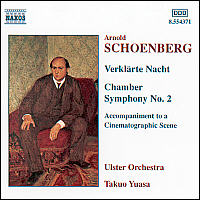At the beginning of the 20th century the Austrian composer, Arnold Schoenberg, rejected tonal music. His new atonal style was to be adopted by his two pupils Berg and Webern, the three becoming known as The Second Viennese School, and were together to change the course of composition. Dispensing with the fundamental concept of melody, he devised a system using all 12 notes of the octave as the 'thematic' basis of each work. In his younger years Schoenberg had produced a number of works in the style of the Romantic era, Verklärte Nacht (Transfigured Night) being an explicit picture of the illicit love we find in Wagner¡¦s opera, Tristan and Isolde. Though image-makers have cast Schoenberg as a musical revolutionary, he did return to a form of tonal music in later life, the Chamber Symphony and the Accompaniment to a film scene proving his mastery of a post-modernist style of composition.
Orchestral Works
